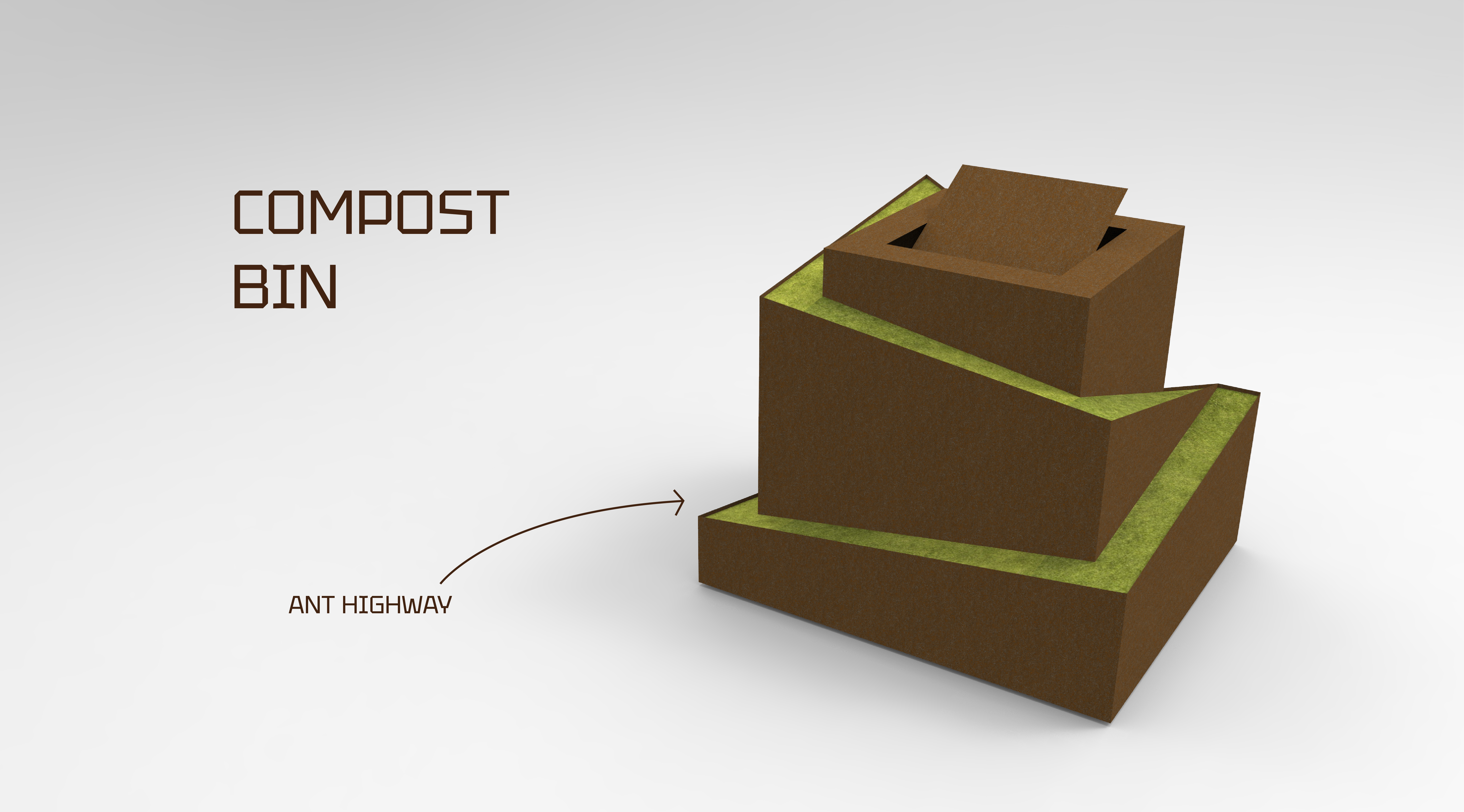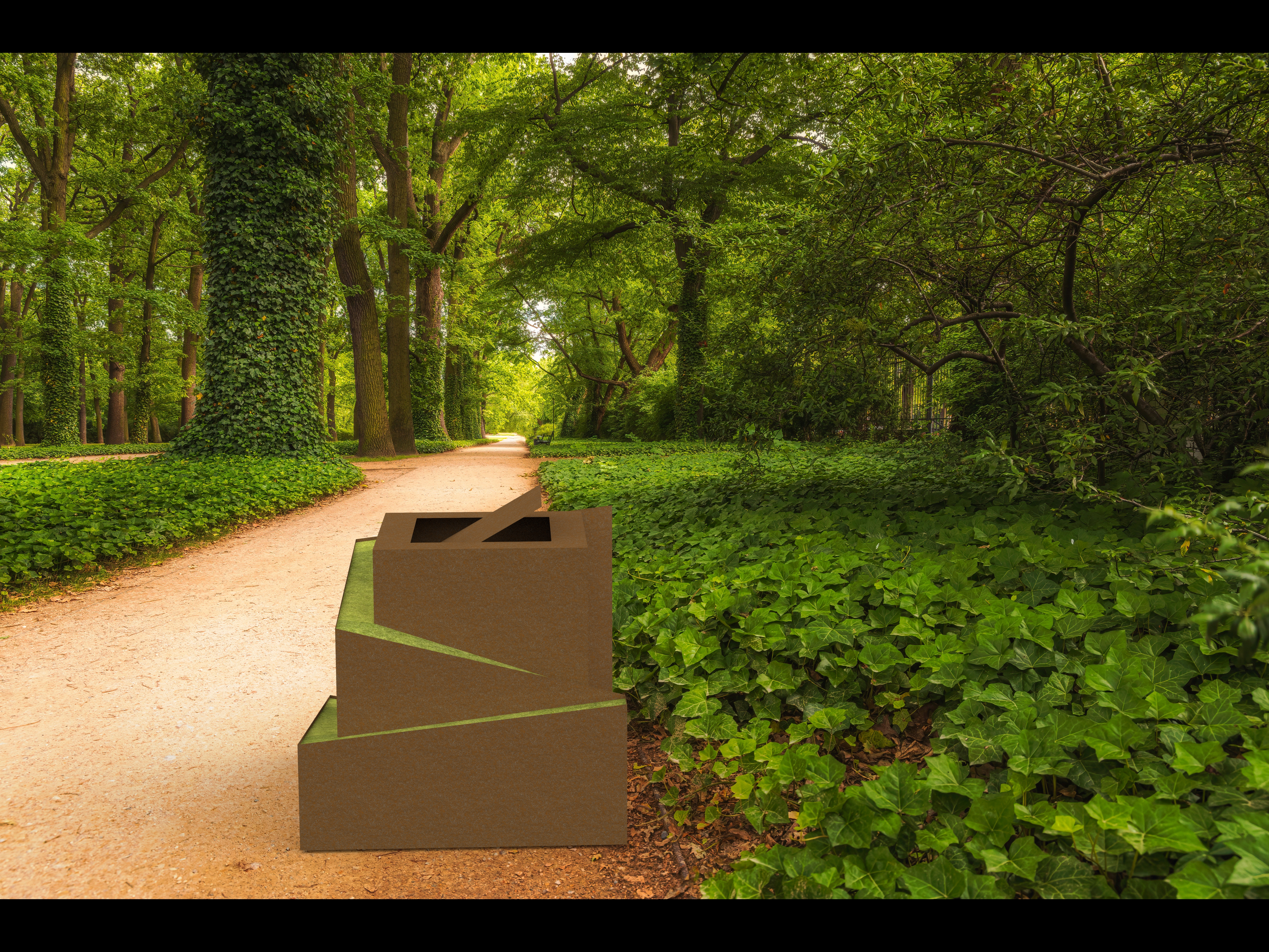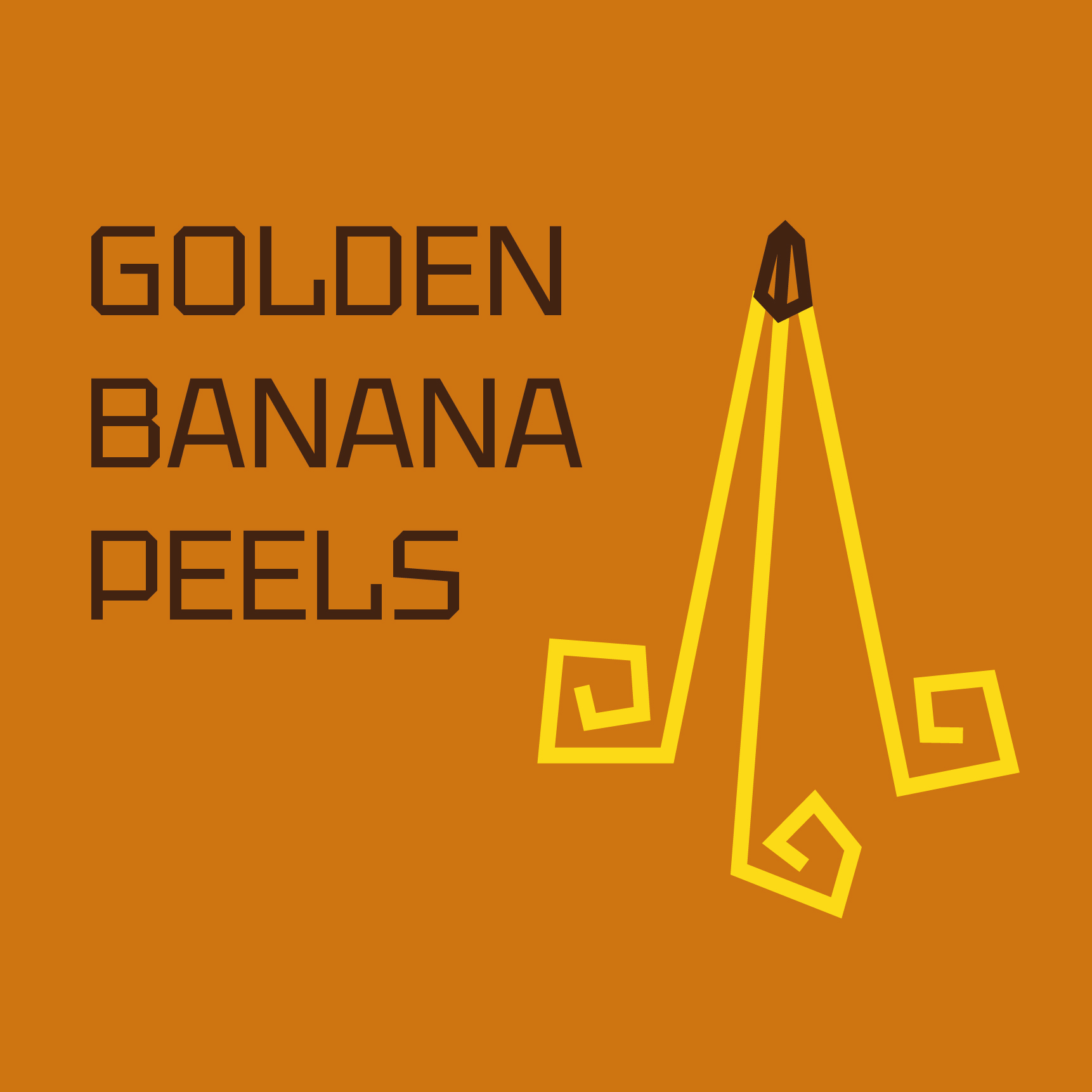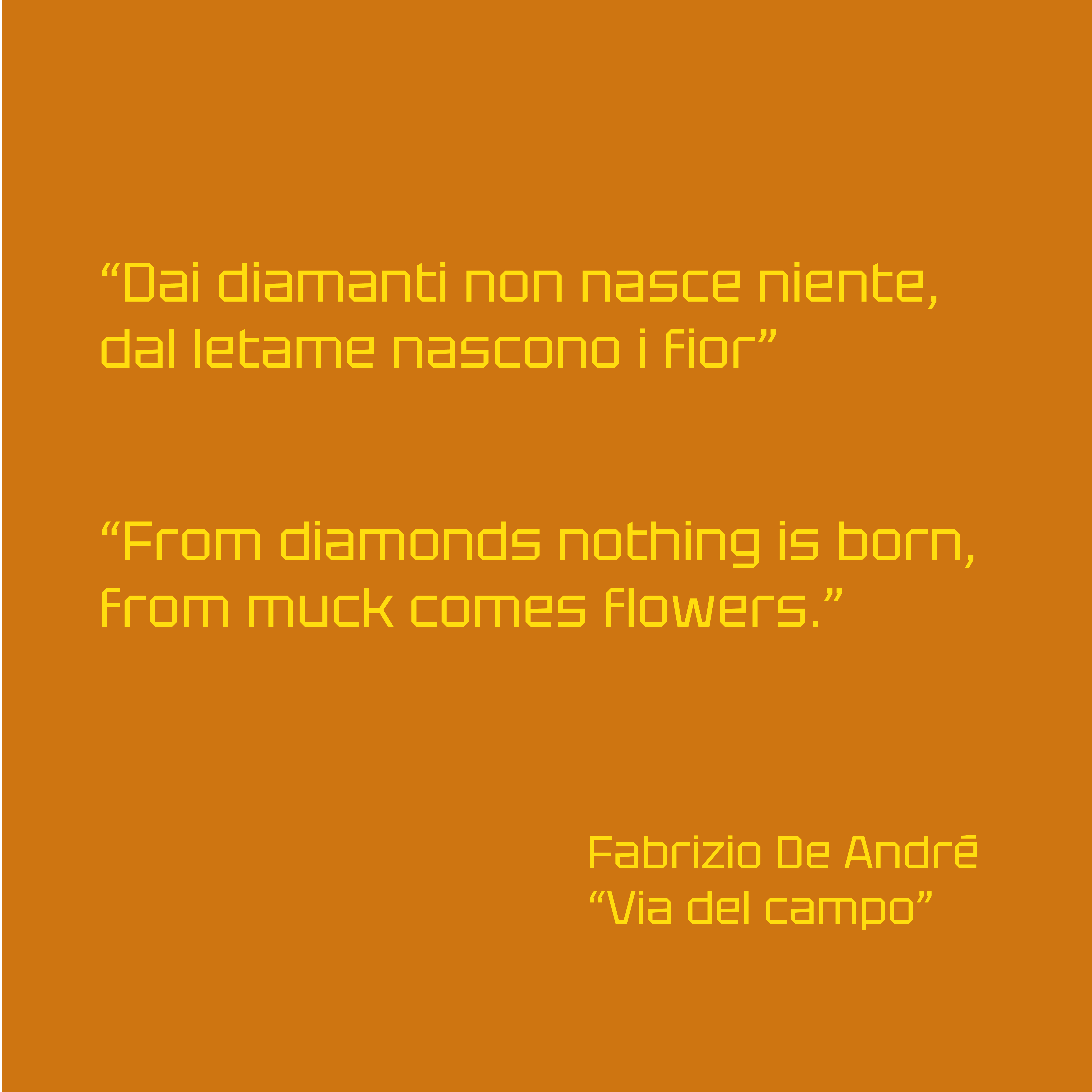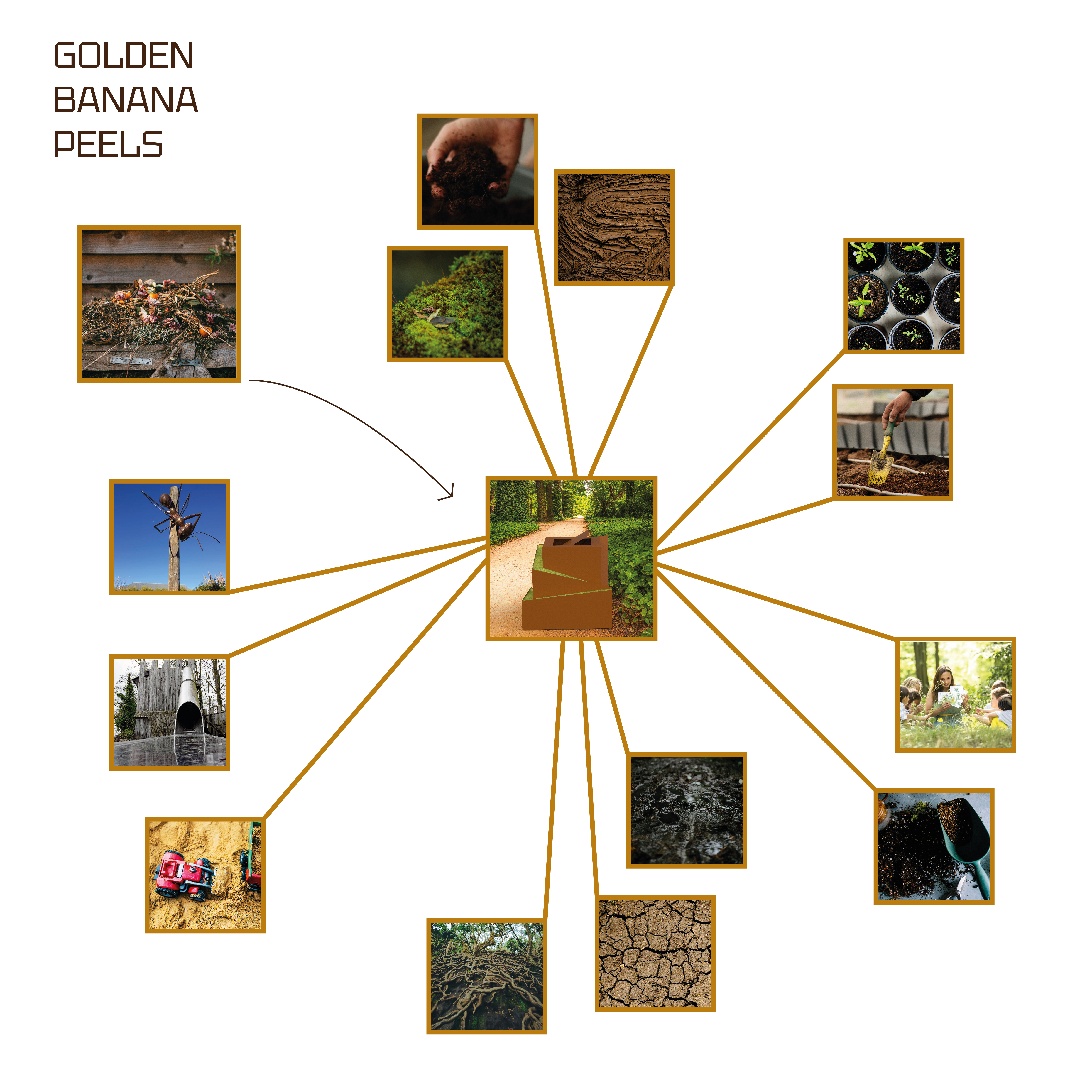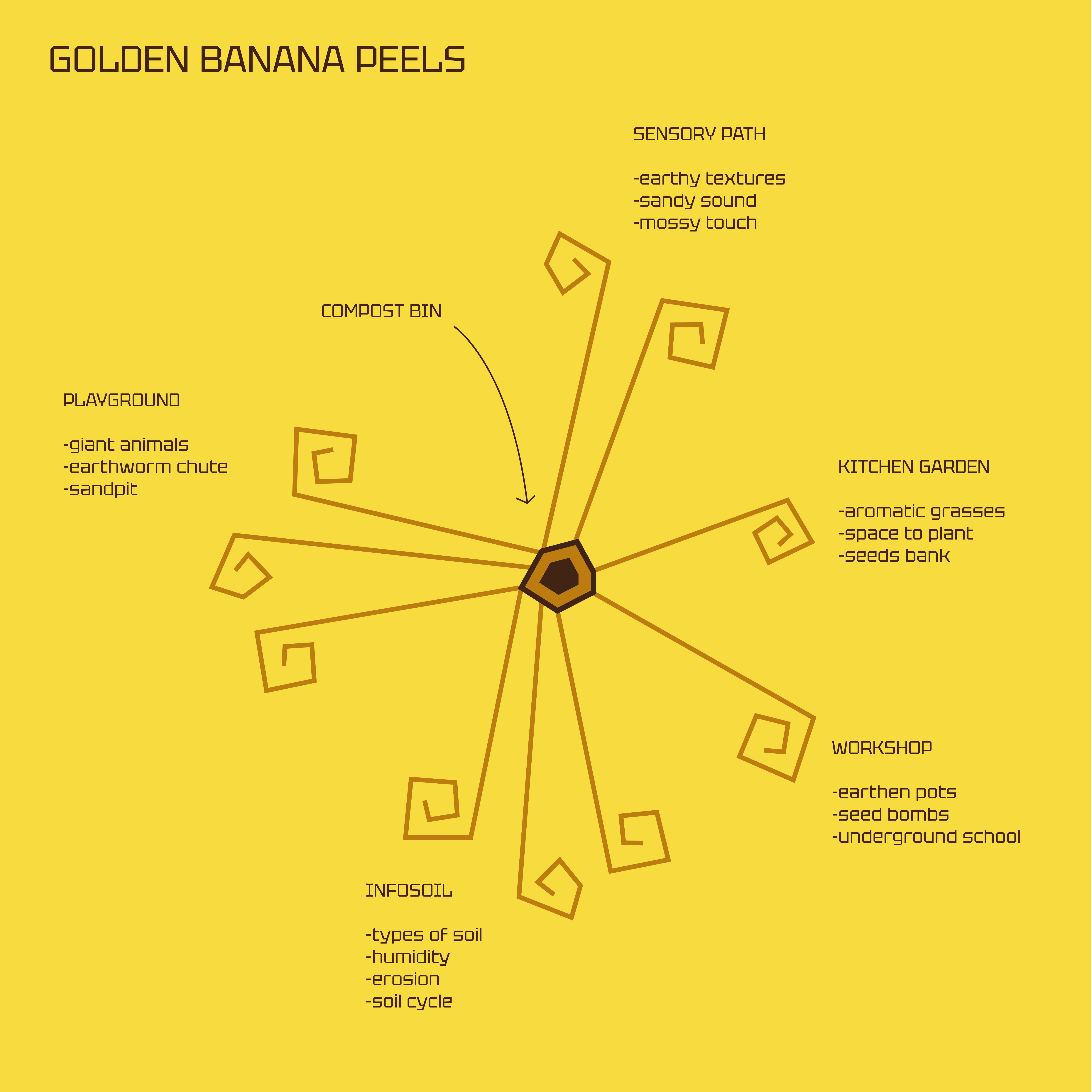Reconnecting with nature
Golden banana peels
A community site to understand and experience the soil, and also to produce humus.
Not many people know what soil is. This knowledge is even more limited for those who live in urban areas and have never had first-hand experience with soil and humus. Not many people know how valuable smelly, decaying organic waste is. Golden Banana Peels is a space within a community where people of different ages come together. It is an educational site, but also a playground, where people see how humus is produced from organic waste. Everyone will see their banana peels differently.
Luxembourg
Local
Luxembourg city
Mainly urban
It refers to other types of transformations (soft investment)
Early concept
No
No
As an individual
Our project was conceived as an educational site, where people of very different ages can go and learn more about soil. The heart of the site, at the centre of it all, is the COMPOST BIN. Humus is produced from organic waste in the neighbourhood and can be used for other purposes.
One section is dedicated to soil science ‘INFOSOIL’, others allow first-hand experience with soil and humus (SENSORY PATH, KITCHEN GARDEN, WORKSHOP). The full version of the site includes a PLAYGROUND (where children can play surrounded by human-scale reproductions of organic waste and insects involved in the decomposition process, earthworm-shaped chute, sandpit).
The soil science area ‘INFOSOIL’ explains in a simple and entertaining way what soil is, how it works, how humus is obtained from organic waste, which insects and natural elements are important in this process, soil fertility, the concept of carbon storage and information on local soils.
The overall objective is to educate adults and children about the importance of the life cycle of organic waste, which is transformed into humus and enriches the soil. The user should learn about the functioning of the soil and the production of humus through the educational material that is always available on site and first-hand experience with humus (e.g. depositing organic waste, observing the process, planting some plants in the humus).
The project is linked to the NEB objective ‘Reconnecting with Nature’ because at the site, people spend time together having fun and learning about nature, how to protect it, while surrounded by nature.
In particular, after spending time at the site, users should look at organic waste from a different perspective and thus learn how to save valuable material, rebuilding a life cycle.
One section is dedicated to soil science ‘INFOSOIL’, others allow first-hand experience with soil and humus (SENSORY PATH, KITCHEN GARDEN, WORKSHOP). The full version of the site includes a PLAYGROUND (where children can play surrounded by human-scale reproductions of organic waste and insects involved in the decomposition process, earthworm-shaped chute, sandpit).
The soil science area ‘INFOSOIL’ explains in a simple and entertaining way what soil is, how it works, how humus is obtained from organic waste, which insects and natural elements are important in this process, soil fertility, the concept of carbon storage and information on local soils.
The overall objective is to educate adults and children about the importance of the life cycle of organic waste, which is transformed into humus and enriches the soil. The user should learn about the functioning of the soil and the production of humus through the educational material that is always available on site and first-hand experience with humus (e.g. depositing organic waste, observing the process, planting some plants in the humus).
The project is linked to the NEB objective ‘Reconnecting with Nature’ because at the site, people spend time together having fun and learning about nature, how to protect it, while surrounded by nature.
In particular, after spending time at the site, users should look at organic waste from a different perspective and thus learn how to save valuable material, rebuilding a life cycle.
soil
lifecycle
learning
science
community
The core of the project is understanding soil and its importance in the earth's ecosystem. The land is where we live, where we can get food, water, minerals and everything we need for our life. A place where the soil is not healthy is not a habitable place. A key process for soil conservation is, first of all, understanding the processes involved. To preserve it, we must keep it alive, use it responsibly and, if possible, take care of it. The project will help to lighten the logistics of waste collection and create locally regenerated raw material. Furthermore, the direct involvement of the population will help to acquire a new awareness of the importance of waste and its management.
In summary, Golden Banana Peels is an example of social sustainability (benefits for people of different ages), economic sustainability (economic benefits for the people involved in the project) and environmental sustainability (circularity and protection of a natural life cycle).
The project (the compost bin and the community site), if replicated in the city, will develop as a network of local organic waste collection points. This will help to close the soil cycle more quickly.
In summary, Golden Banana Peels is an example of social sustainability (benefits for people of different ages), economic sustainability (economic benefits for the people involved in the project) and environmental sustainability (circularity and protection of a natural life cycle).
The project (the compost bin and the community site), if replicated in the city, will develop as a network of local organic waste collection points. This will help to close the soil cycle more quickly.
The project aims to bring users to rediscover or learn about soil and its importance through concrete action. In simple words, citizens will be involved in the process of creating humus through the collection and storage of organic waste. The COMPOST BIN, the focal point of this project, is a magnifying glass on a process that is constantly happening all over the planet and is the basis of life itself. The citizen will be a facilitator of this process in the urban context, a place where he or she is normally prevented from experiencing it. The compost bin will primarily be a place to reevaluate waste (waste that is regenerated will become raw material) but also a place to learn basics about the science behind soil and its regeneration cycle. In the most idealistic vision, the compost bin and the surrounding space will be a place for social gathering and that will therefore allow for the development of various learning, play and maintenance activities starting with the regenerated raw material: soil. To this end, the installation should be attractive to different age groups, presenting the theme in a varied and engaging manner. It should also involve the 5 senses of visitors (touch, smell, sight, taste, hearing). For example, while the children will play, attracted by the giant sculptures of ants and earthworms, on the other side an elderly person can take care of his seedlings grown from the humus of the compost bin.
In choosing the shape of the design, we sought inspiration from nature, we wanted to avoid excessively rigid shapes.
With respect to the shape of the compost bin, it is reminiscent of the plan of the project, characterised by a curled line (inspired by the golden spiral - a geometric configuration).
The shape of the plan (recalled in the logo) is also inspired by the golden spiral, allowing space to be maximised, creating separate but still communicating sections, which orbit around the compost bin.
In choosing the shape of the design, we sought inspiration from nature, we wanted to avoid excessively rigid shapes.
With respect to the shape of the compost bin, it is reminiscent of the plan of the project, characterised by a curled line (inspired by the golden spiral - a geometric configuration).
The shape of the plan (recalled in the logo) is also inspired by the golden spiral, allowing space to be maximised, creating separate but still communicating sections, which orbit around the compost bin.
The installation is designed to be suitable for all ages. In addition, it is intended to be accessible to people with physical disabilities, including deaf or blind people. The aim is also to include less affluent people among the users.
First of all, the INFOSOIL, the KITCHEN GARDEN and SENSORY PATH will entertain seniors, adults and young people. For younger users, a thematic playground is planned.
For persons with limited mobility in wheelchairs or for children in prams/pushchairs, walkways suitable for their passage that connect the compost bin with the other areas will be provided.
A deaf or blind person can have a satisfying experience because all 5 senses will be involved in this installation. For example, the experience is designed to be effective even without reading, through other tactile experiences (different textures of soil on display, tactile pathways to guide, ideally explanations in Braille).
In addition, information on soil and organic waste processing should be translated into different languages, carefully selected to represent local people.
Finally, most of the installation should be accessible without payment and is intended as a public area. Exceptions are the use of the central compost bin and the availability of land for private cultivation, which is reserved for households regularly participating in the project.
First of all, the INFOSOIL, the KITCHEN GARDEN and SENSORY PATH will entertain seniors, adults and young people. For younger users, a thematic playground is planned.
For persons with limited mobility in wheelchairs or for children in prams/pushchairs, walkways suitable for their passage that connect the compost bin with the other areas will be provided.
A deaf or blind person can have a satisfying experience because all 5 senses will be involved in this installation. For example, the experience is designed to be effective even without reading, through other tactile experiences (different textures of soil on display, tactile pathways to guide, ideally explanations in Braille).
In addition, information on soil and organic waste processing should be translated into different languages, carefully selected to represent local people.
Finally, most of the installation should be accessible without payment and is intended as a public area. Exceptions are the use of the central compost bin and the availability of land for private cultivation, which is reserved for households regularly participating in the project.
Citizens are not just passive spectators.
The main activity is to operate the composter, i.e. to fill it with organic waste from households or various urban activities. This will always provide new compost that will be useful for secondary activities in the site (WORKSHOP, KITCHEN GARDEN, SENSORY PATH) or for use in other city gardens or flowerbeds.
Citizens who join the programme and decide to use the compost bin will be financially bound to the projects. They will have an economic advantage with cheaper organic waste collection (very cheap tax for the collection of organic waste). The partial tax exemption is justified by the fact that they will reduce transport and handling costs and thus provide a service to their city/neighbourhood/building block.
Participants in the programme may also request access to a small plot of land to cultivate and/or to obtain humus on a regular basis for an extra fee.
It is expected that the rest of the citizens using the site will be stimulated to be active, walking along the sensory path, or reading at the INFOSOIL, or touching the soil (e.g. SENSORY PATH), admiring the decomposition process of organic waste (thanks to glass portholes).
Schools and associations can participate in soil workshops organised in the dedicated area or use this installation for their own learning programmes. Ideally, local farmers, agronomists or scholars could be invited and they could became a reference for the site, using it as a hub to disseminate their knowledge.
The main activity is to operate the composter, i.e. to fill it with organic waste from households or various urban activities. This will always provide new compost that will be useful for secondary activities in the site (WORKSHOP, KITCHEN GARDEN, SENSORY PATH) or for use in other city gardens or flowerbeds.
Citizens who join the programme and decide to use the compost bin will be financially bound to the projects. They will have an economic advantage with cheaper organic waste collection (very cheap tax for the collection of organic waste). The partial tax exemption is justified by the fact that they will reduce transport and handling costs and thus provide a service to their city/neighbourhood/building block.
Participants in the programme may also request access to a small plot of land to cultivate and/or to obtain humus on a regular basis for an extra fee.
It is expected that the rest of the citizens using the site will be stimulated to be active, walking along the sensory path, or reading at the INFOSOIL, or touching the soil (e.g. SENSORY PATH), admiring the decomposition process of organic waste (thanks to glass portholes).
Schools and associations can participate in soil workshops organised in the dedicated area or use this installation for their own learning programmes. Ideally, local farmers, agronomists or scholars could be invited and they could became a reference for the site, using it as a hub to disseminate their knowledge.
We are planning to involve the municipalities of the cities where we live (Luxembourg City in particular and Piombino Dese). They will be instrumental in granting permission to install the site in a public area of the city, ideally in a neighbourhood, near a garden, in a residential area, near a school.
Interesting partners could be universities, which represent a pool of young professionals and experts, from designers to soil scientists. They will be mostly included in the design phase or in case of site maintenance problems. Other experts from private companies (e.g. Scienza del suolo.org) or specific soil associations (AIPAS no till) will participate in the preparation of the INFOSOIL area (design phase) and will be invited to give lectures in the workshop area
For maintenance purposes, waste management companies, gardeners, and park maintainers will be involved.
Interesting partners could be universities, which represent a pool of young professionals and experts, from designers to soil scientists. They will be mostly included in the design phase or in case of site maintenance problems. Other experts from private companies (e.g. Scienza del suolo.org) or specific soil associations (AIPAS no till) will participate in the preparation of the INFOSOIL area (design phase) and will be invited to give lectures in the workshop area
For maintenance purposes, waste management companies, gardeners, and park maintainers will be involved.
A number of experts in the sciences are to be involved in the implementation of the project: biology, microbiology, and chemistry, but also design and urban planning. Their expertise will first be needed to design an efficient and problem-free composter in the urban context. Then their intervention will be necessary for the creation of the content and user experiences that will take place in the context of the composter. Among these certainly of great importance will be the learning areas about the soil: the chemistry behind decomposition, the morphology of the soils, the animals that live there and are involved in the process, etc.
In addition, it will be necessary to adapt the project to the specific city context respecting the local aesthetic canons and therefore being consistent in the choice of materials and installations, in this regard the intervention of an architect could be useful.
Finally, to make the business work, finance and reporting skills will be needed for the accounting part and communication/story telling to raise awareness and expand the visibility of the project.
In addition, it will be necessary to adapt the project to the specific city context respecting the local aesthetic canons and therefore being consistent in the choice of materials and installations, in this regard the intervention of an architect could be useful.
Finally, to make the business work, finance and reporting skills will be needed for the accounting part and communication/story telling to raise awareness and expand the visibility of the project.
First of all, our installation gives value to a product that is considered a stinking waste. This goal is innovative in itself.
In the context of our project, attention is drawn to the process of transformation of organic matter that is considered disgusting and is actually the basis of our existence, without which we would not even exist. We want the users of our installation to come to the same conclusion and to recognise that organic waste is a valuable resource.
In terms of design, it is innovative that the installation is designed to be modular and scalable. The project can be implemented with a small budget, focusing initially on one aspect (the COMPOSTER BIN) and integrating it with other elements over time (e.g. INFOSOIL, SENSORY PATH (textures and composition of different soil typologies), PLAYGROUND, WORKSHOP area, the area with ground available for cultivation in the KITCHEN GARDEN) For this reason, the core elements of the installation can be a solution for the neighbourhood, for a single block of flats, or for the whole city.
It is innovative to bring soil culture to an urban area, to citizens who have never experienced it first-hand. It is to underline that the aesthetic component is also strong in the installation. In other words, the ultimate goal is for the user to take home knowledge about soil and organic waste, but we want them to have a pleasant sensory experience and enjoy something aesthetically beautiful. Finally, the composter is designed to be useful for the neighbourhood and it also brings an economic benefit.
In the context of our project, attention is drawn to the process of transformation of organic matter that is considered disgusting and is actually the basis of our existence, without which we would not even exist. We want the users of our installation to come to the same conclusion and to recognise that organic waste is a valuable resource.
In terms of design, it is innovative that the installation is designed to be modular and scalable. The project can be implemented with a small budget, focusing initially on one aspect (the COMPOSTER BIN) and integrating it with other elements over time (e.g. INFOSOIL, SENSORY PATH (textures and composition of different soil typologies), PLAYGROUND, WORKSHOP area, the area with ground available for cultivation in the KITCHEN GARDEN) For this reason, the core elements of the installation can be a solution for the neighbourhood, for a single block of flats, or for the whole city.
It is innovative to bring soil culture to an urban area, to citizens who have never experienced it first-hand. It is to underline that the aesthetic component is also strong in the installation. In other words, the ultimate goal is for the user to take home knowledge about soil and organic waste, but we want them to have a pleasant sensory experience and enjoy something aesthetically beautiful. Finally, the composter is designed to be useful for the neighbourhood and it also brings an economic benefit.
After deciding to apply to the New European Bauhaus prizes 2025, our focus among the proposed objectives was ‘connecting with nature’.
In this context, we identified the need in cities to reconnect with the soil, avoid wasting organic waste and to learn how to recover it and to make it a resource.
Our approach was to gather ideas through brainstorming and a moodboard.
To explore the topic further, our method included research, preparation of a business plan and a SWOT analysis. We researched how compost bins are made, the soil processes and the state of the art in this field, trying to find out if a similar project on compost had already been implemented.
This method provided us with insights and contents to complete our application.
In parallel, we worked on sketches of the shape of our installation, trying to visualise it by preparing freehand sketches and 3D digital sketches. Our drawings were based on the principle of optimising space, aesthetics, connection with nature, and the necessity to adapt the shape to the physical characteristics of the materials.
In this context, we identified the need in cities to reconnect with the soil, avoid wasting organic waste and to learn how to recover it and to make it a resource.
Our approach was to gather ideas through brainstorming and a moodboard.
To explore the topic further, our method included research, preparation of a business plan and a SWOT analysis. We researched how compost bins are made, the soil processes and the state of the art in this field, trying to find out if a similar project on compost had already been implemented.
This method provided us with insights and contents to complete our application.
In parallel, we worked on sketches of the shape of our installation, trying to visualise it by preparing freehand sketches and 3D digital sketches. Our drawings were based on the principle of optimising space, aesthetics, connection with nature, and the necessity to adapt the shape to the physical characteristics of the materials.
The project is designed to be scalable. It has to be replicated by cities/countries that dispose of many or few financial resources.
It is composed of an essential part, namely the COMPOST BIN, and some other elements that can complement it. The elements that can be added are, in order of priority, the INFOSOIL (regarding soil, insects, carbon storage, soil typologies), the SENSORY PATH (textures of different soil typologies), the PLAYGROUND, the area with ground available for cultivation in the KITCHEN GARDEN and the WORKSHOP.
According to the needs of the community/city, it is possible to choose among different configurations. For example, in some cases, the ideal solution could be the installation of many COMPOST BINS in the city, in other cases, the installation of one single COMPOST BIN (integrated with all the other elements mentioned above) could be more convenient. This choice depends on different factors, such as, for example, urban dislocation, land availability, financial resources and morphology of the territory.
It is composed of an essential part, namely the COMPOST BIN, and some other elements that can complement it. The elements that can be added are, in order of priority, the INFOSOIL (regarding soil, insects, carbon storage, soil typologies), the SENSORY PATH (textures of different soil typologies), the PLAYGROUND, the area with ground available for cultivation in the KITCHEN GARDEN and the WORKSHOP.
According to the needs of the community/city, it is possible to choose among different configurations. For example, in some cases, the ideal solution could be the installation of many COMPOST BINS in the city, in other cases, the installation of one single COMPOST BIN (integrated with all the other elements mentioned above) could be more convenient. This choice depends on different factors, such as, for example, urban dislocation, land availability, financial resources and morphology of the territory.
As the World Economic Forum explains, an overheated world is one of the global challenges, most likely the greatest.
In this context, how can our project address this gigantic challenge with local level solutions? The ‘humus first-hand experience’ aims to raise awareness of soil functioning. Understanding how the soil works, or understanding that there are ploughing systems that are less harmful in terms of increasing CO2 in the atmosphere is important. Spreading these concepts is fundamental. In this sense, our learning hub can be helpful.
Furthermore, adapting and preparing for a changing climate requires approaches such as the circular economy and resource optimisation.
In these terms, our project aims to show the life cycle of organic waste and let citizens experience this circularity of organic waste (by looking at it, touching it, smelling it, experiencing the whole cycle). In our installation, waste becomes a resource, and the resource is not wasted. Ideally, citizens should learn from this experience and apply the lessons learnt in their everyday lives.
In particular, the project presents some cross-cutting objectives with the following Global goals of the UN 2030 Agenda: Goal 15, ‘Life on land’, because the installation aims to promote the sustainable use of the terrestrial ecosystem; Goal 13, ‘Climate action’, because the project could be considered a small local action to combat climate change and its impacts; Goal 12, ‘Responsible consumption and production’, because it’s a lesson in waste reuse; Goal 11, ‘Sustainable cities and communities’, because the site should bring together a community of people who orbit around the composter, either for educational purposes or for economic and practical benefits.
In this context, how can our project address this gigantic challenge with local level solutions? The ‘humus first-hand experience’ aims to raise awareness of soil functioning. Understanding how the soil works, or understanding that there are ploughing systems that are less harmful in terms of increasing CO2 in the atmosphere is important. Spreading these concepts is fundamental. In this sense, our learning hub can be helpful.
Furthermore, adapting and preparing for a changing climate requires approaches such as the circular economy and resource optimisation.
In these terms, our project aims to show the life cycle of organic waste and let citizens experience this circularity of organic waste (by looking at it, touching it, smelling it, experiencing the whole cycle). In our installation, waste becomes a resource, and the resource is not wasted. Ideally, citizens should learn from this experience and apply the lessons learnt in their everyday lives.
In particular, the project presents some cross-cutting objectives with the following Global goals of the UN 2030 Agenda: Goal 15, ‘Life on land’, because the installation aims to promote the sustainable use of the terrestrial ecosystem; Goal 13, ‘Climate action’, because the project could be considered a small local action to combat climate change and its impacts; Goal 12, ‘Responsible consumption and production’, because it’s a lesson in waste reuse; Goal 11, ‘Sustainable cities and communities’, because the site should bring together a community of people who orbit around the composter, either for educational purposes or for economic and practical benefits.
_feasibility analysis with the interested municipality
_agreement with other stakeholders
_budget, analysis of main expenses
_budget allocation
_quotations and evaluation regarding the executive project
_implementation plan, timetable, maintenance programme
_monitoring of the achievements and programme relevance
_promotion of the project
_agreement with other stakeholders
_budget, analysis of main expenses
_budget allocation
_quotations and evaluation regarding the executive project
_implementation plan, timetable, maintenance programme
_monitoring of the achievements and programme relevance
_promotion of the project

